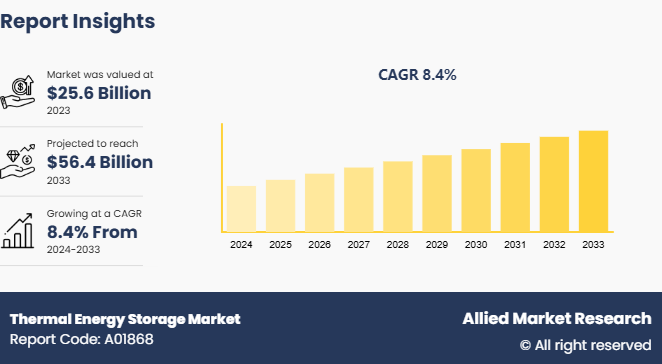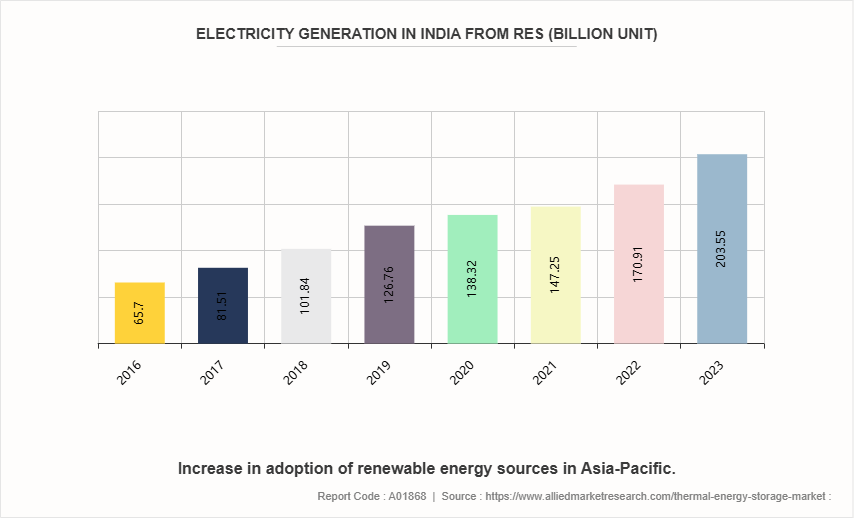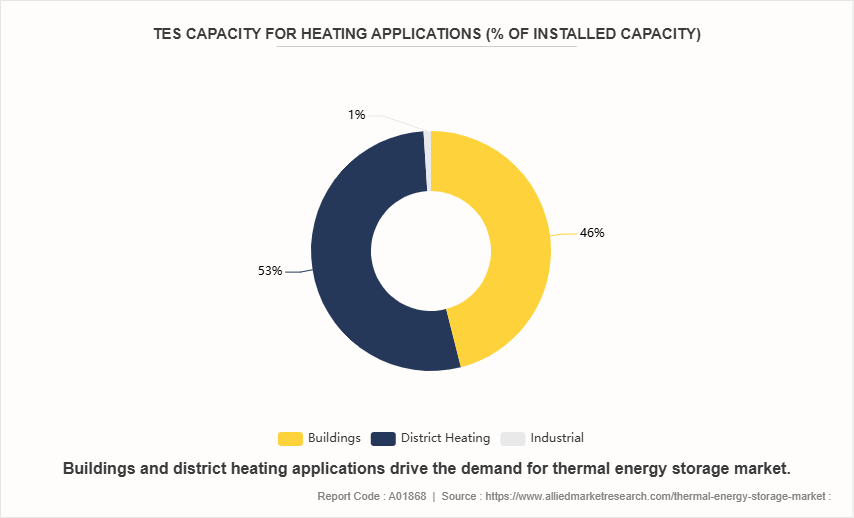Thermal Energy Storage Market
P
2024
Thermal Energy Storage Market Size, Share, Competitive Landscape and Trend Analysis Report, by Technology, by Storage Material by Application by End Use : Global Opportunity Analysis and Industry Forecast, 2024-2033
Thermal Energy Storage Market Research, 2033
The global thermal energy storage market size was valued at $25.6 billion in 2023, and is projected to reach $56.4 billion by 2033, growing at a CAGR of 8.4% from 2024 to 2033.

Market Introduction and Definition
Thermal energy storage (TES) is a technology that stores thermal energy by heating or cooling a storage medium. This process is critical for balancing the demand & supply of energy, particularly in systems where the energy source is intermittent such as solar or wind power. TES helps improve energy efficiency and reliability by storing excess thermal energy when it is abundant and release during periods of high demand or when the energy source is unavailable.
Key Takeaways
- The thermal energy storage market study covers 20 countries. The research includes a segment analysis of each country in terms of value for the projected period.
- More than 1,500 product literatures, industry releases, annual reports, and other such documents of major thermal energy storage industry participants along with authentic industry journals, trade associations' releases, and government websites have been reviewed for generating high-value industry insights.
- The study integrated high-quality data, professional opinions and analysis, and critical independent perspectives. The research approach is intended to provide a balanced view of global markets and to assist stakeholders in making educated decisions to achieve their most ambitious growth objectives.
Key Market Dynamics
TES solutions play a crucial role in advancing sustainability objectives by enabling the widespread deployment of renewable energy technologies. These intermittent and variable renewable energy sources pose significant challenges to grid stability and reliability. However, by incorporating TES systems into renewable energy infrastructure, excess energy generated during favorable conditions is stored for later use, smoothing out fluctuations in supply & demand and improving overall system reliability. All these factors are expected to drive the demand for thermal energy storage market during the forecast period.
However, the declining costs and increasing efficiency of alternative storage technologies pose a challenge to the competitiveness of TES solutions. As economies of scale drive down the prices of batteries and other storage technologies, the cost advantage of TES systems diminishes, particularly for applications requiring short-duration storage or high-power output. In addition, ongoing R&D efforts aimed at improving the performance and reliability of alternative storage technologies further erode the market share of TES solutions over time. All these factors hamper the thermal energy storage market growth.
Government incentives drive the market demand for TES technologies and incentivize private sector investment. These incentives take various forms such as tax credits, grants, subsidies, and low-interest loans, aimed at reducing the upfront costs and financial barriers associated with deploying TES systems. By providing financial incentives for energy efficiency improvements and renewable energy integration, governments accelerate the adoption of TES solutions across residential, commercial, industrial, and utility sectors. All these factors are anticipated to offer new growth opportunities for the thermal energy storage market.
Market Segmentation
The global thermal energy storage market is segmented into technology, storage material, application, end use, and region. On the basis of technology, the market is divided into latent heat storage, sensible heat storage and others. By storage material, the market is segmented into water, molten salt, phase change material (PCM) , and others. On the basis of application, the market is categorized into power generation, heating, and cooling. By end use, the market is segmented residential, commercial & industrial, and utilities. Region-wise the market is analyzed across North America, Europe, Asia-Pacific, and LAMEA.
Regional Market Outlook
The Asia-Pacific region is rapidly increasing its adoption of renewable energy sources, such as solar and wind power. However, the intermittent nature of these energy sources poses a significant challenge to grid stability and reliability. Thermal energy storage (TES) systems offer a viable solution to this problem by storing excess energy generated during peak production times and releasing it during periods of high demand or low production. This integration of TES with renewable energy systems ensures a stable and continuous supply of electricity, thereby enhancing grid resilience and supporting the region's transition to a more sustainable energy mix.

-
Governments across the Asia-Pacific region is implementing policies and incentives to promote energy storage technologies, including TES. China’s ambitious energy storage targets and India’s National Solar Mission emphasize the importance of energy storage solutions to achieve renewable energy goals.
-
Innovations in TES technologies, such as phase change materials (PCMs) and molten salt storage, are improving the efficiency and cost-effectiveness of thermal storage systems. These advancements are making TES more viable for large-scale applications.
-
Industries in the Asia-Pacific region is increasingly adopting TES for process heating and cooling, which helps in reducing energy consumption and operational costs.
-
The fluctuating and often rising energy prices in the region are pushing businesses and residential users to look for alternative energy storage solutions to manage costs effectively.
Competitive Landscape
The major players operating in the thermal energy storage industry include Aalborg CSP, Abengoa, Cartesian, Enel Spa, EVAPCO, Inc, Kraftblock GmbH, Lumenion GmbH, Magaldi Green Energy, Man energy solutions, PCM products ltd., Phelas GmbH, Spirax sarco limited., Sunamp Ltd., and Thermofin.
Industry Trends
- TES systems are becoming more integral to renewable energy projects, particularly solar and wind. They help store excess energy generated during peak production times for use during periods of low generation.
- The surge in integration of renewable energy sources significantly drives the demand for thermal energy storage (TES) systems. According to the Internation Energy Agency (IEA) , by 2026, global renewable electricity capacity is forecast to rise more than 60% from 2020 levels to over 4, 800 GW.
- Government policies and incentives promoting energy storage and renewable energy adoption are driving the growth of TES. Various countries are implementing regulatory frameworks that encourage the deployment of TES systems.
- TES plays a crucial role in decarbonization strategies by enabling the use of renewable energy and reducing reliance on fossil fuels. This aligns with global goals to reduce greenhouse gas emissions.
TES Capacity for Heating Applications (% of Installed capacity)
The installed thermal energy storage capacity with 46% dedicated to buildings, 53% to district heating, and 1% to industrial applications, highlights a strategic emphasis on enhancing heating efficiency across residential, commercial, and large-scale district systems. This distribution reflects a concerted effort to manage and optimize heating loads in buildings, which reduces energy consumption and heating costs while improving comfort. The substantial investment in district heating systems underscores a commitment to efficient, centralized heat distribution, potentially lowering emissions and operational costs. However, the minimal focus on industrial applications suggests an opportunity for growth in this sector, where increased thermal energy storage leads to better energy management and sustainability.

Key Sources Referred
- International Energy Agency
- U.S. Department of Energy
- Renewable Thermal Collaborative
- International Renewable Energy Agency (IRENA)
- Asian Development Bank
- The American Clean Power Association
Key Benefits for Stakeholders
- This report provides a quantitative analysis of the market segments, current trends, estimations, and dynamics of the thermal energy storage market analysis from 2024 to 2033 to identify the prevailing thermal energy storage market opportunities.
- The market research is offered along with information related to key drivers, restraints, and opportunities.
- Porter's five forces analysis highlights the potency of buyers and suppliers to enable stakeholders make profit-oriented business decisions and strengthen their supplier-buyer network.
- In-depth analysis of the thermal energy storage market forecast and segmentation assists to determine the prevailing market opportunities.
- Major countries in each region are mapped according to their thermal energy storage market share in the global market.
- Market player positioning facilitates benchmarking and provides a clear understanding of the present position of the market players.
- The report includes the analysis of the regional as well as global thermal energy storage market trends, key players, market segments, application areas, and market growth strategies.
Thermal Energy Storage Market Report Highlights
| Aspect | Details |
|---|---|
Market Size By 2033 | USD 56.4 Billion |
Growth Rate | CAGR of 8.4% |
Forecast period | 2024 - 2033 |
Report Pages | 420 |
By Technology |
|
By Storage Material |
|
By Application |
|
By End Use |
|
By Region |
|
Key Market Players | Abengoa, Phelas GmbH, Magaldi Green Energy, Cartesian, Sunamp Ltd., Man Energy Solutions, Enel Spa, Spirax Sarco limited., Thermofin, Aalborg CSP, EVAPCO, Inc, PCM Products Ltd., Kraftblock GmbH, Lumenion GmbH |
Analyst Review
Thermal energy storage, also known as heat energy, is utilized to store energy for later use. It is mature energy storage technology, currently gaining popularity in commercial & institutional building applications. It is simple & highly efficient method of transferring energy, and is one of the most feasible eco-friendly solutions for energy saving. It is extensively adopted to stock cold winter air for air conditioning purposes in summers and to store solar energy for space heating in winters. It has gained popularity as an advanced energy technology for thermal applications such as space heating and cooling & air conditioning. It is used for balancing the supply & demand of energy and routinely cater to the varying energy demands.
In 2016, the sensible heat storage segment accounted for more than half share of the total market. Sensible heat storage is most commonly used method for heat & cold storage, owing to its low heat losses. It is used in various end-use industries, owing to its cost benefits. In 2016, the water segment accounted for more than one-third share of the total market. The residential end-use segment is estimated to grow at the highest CAGR of 12.2% from 2017 to 2023.
North America is expected to be the most significant market for thermal energy storage from 2017 to 2023. U.S. dominated the North America thermal energy storage market in 2016. North America witnessed the highest demand for thermal energy storage, owing to the high energy storage capacity and increase in penetration of thermal storage particularly in the U.S. In addition, rapid penetration of renewable energy has changed the energy landscape in this region. In addition, Asia-Pacific is expected to grow at the highest CAGR of 11.6% during the forecast period.
Related Tags
Energy StorageFrequently Asked Questions?
The global thermal energy storage market was valued at $25.6 billion in 2023, and is projected to reach $56.4 billion by 2033, growing at a CAGR of 8.4% from 2024 to 2033.
Favorable government initiatives and regulations is the upcoming trends of Thermal Energy Storage Market in the globe.
Heating is the leading application of Thermal Energy Storage Market.
Europe is the largest regional market for Thermal Energy Storage,
The major players operating in the thermal energy storage market include Aalborg CSP, Abengoa, Cartesian, Enel Spa, EVAPCO, Inc, Kraftblock GmbH, Lumenion GmbH, Magaldi Green Energy, Man energy solutions, PCM products ltd., Phelas GmbH, Spirax sarco limited., Sunamp Ltd., and Thermofin.

